Two Moons Of Uranus: Titania And Oberon. Both Moons Were Discovered By William Herschel In 1787.
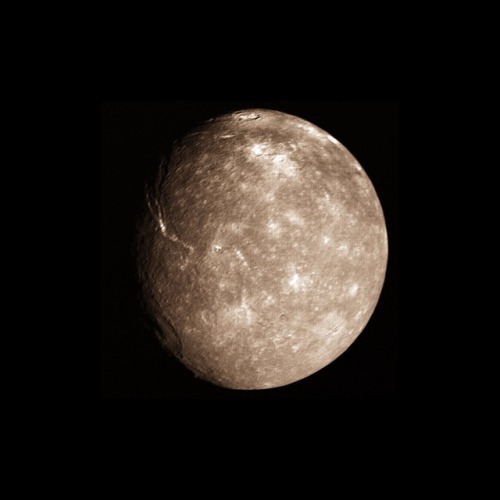

Two moons of Uranus: Titania and Oberon. Both moons were discovered by William Herschel in 1787.
Credit: NASA/JPL
More Posts from Xyhor-astronomy and Others

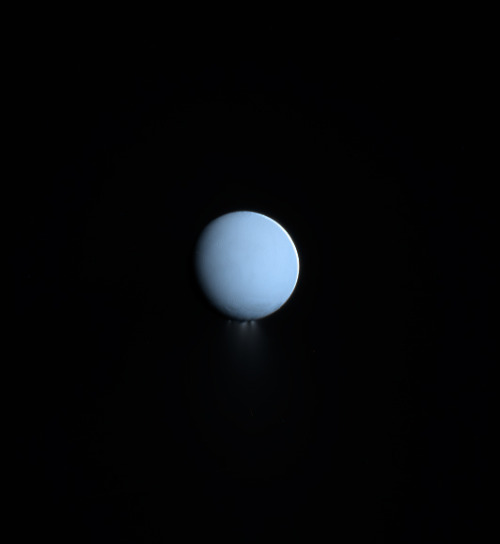



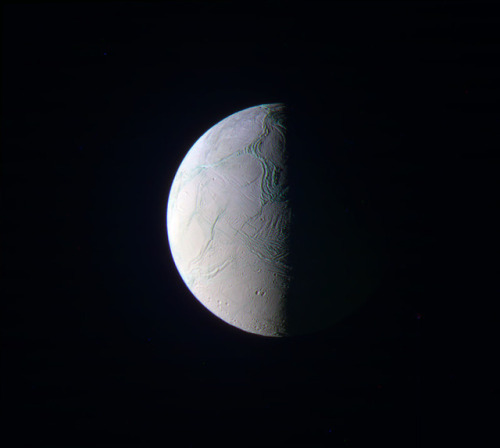

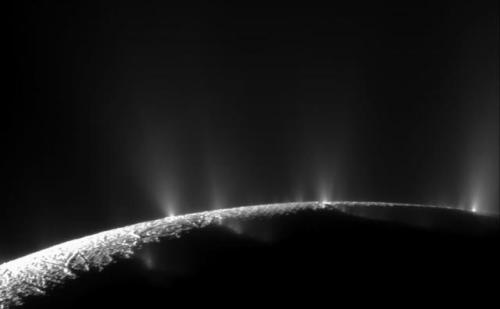

Enceladus
Enceladus is one of the major inner moons of Saturn along with Dione, Tethys, and Mimas. It orbits Saturn at a distance of 148,000 miles (238,000 km), falling between the orbits of Mimas and Tethys. It is tidally locked with Saturn, keeping the same face toward the planet. It completes one orbit every 32.9 hours within the densest part of Saturn’s E Ring, the outermost of its major rings, and is its main source.
Enceladus is, like many moons in the extensive systems of the giant planets, trapped in an orbital resonance. Its resonance with Dione excites its orbital eccentricity, which is damped by tidal forces, tidally heating its interior, and possibly driving the geological activity.
Enceladus is Saturn’s sixth largest moon, only 157 miles (252 km) in mean radius, but it’s one of the most scientifically compelling bodies in our solar system. Hydrothermal vents spew water vapor and ice particles from an underground ocean beneath the icy crust of Enceladus. This plume of material includes organic compounds, volatile gases, carbon dioxide, carbon monoxide, salts and silica.
With its global ocean, unique chemistry and internal heat, Enceladus has become a promising lead in our search for worlds where life could exist.

In 2005, Cassini’s multiple instruments discovered that this icy outpost is gushing water vapor geysers out to a distance of three times the radius of Enceladus. The icy water particles are roughly one ten-thousandth of an inch, or about the width of a human hair. The particles and gas escape the surface at jet speed at approximately 800 miles per hour (400 meters per second). The eruptions appear to be continuous, refreshing the surface and generating an enormous halo of fine ice dust around Enceladus, which supplies material to one of Saturn’s rings, the E-ring.
Several gases, including water vapor, carbon dioxide, methane, perhaps a little ammonia and either carbon monoxide or nitrogen gas make up the gaseous envelope of the plume.
Read more at: solarsystem.nasa.gov
Image credit: NASA/JPL/Cassini & Kevin Gill
(CNN) On October 19, the Pan-STARRS 1 telescope in Hawaii spotted something strange zooming through our solar system. It turned out to be a visitor from beyond our solar system, and it's unlike anything astronomers have seen before.
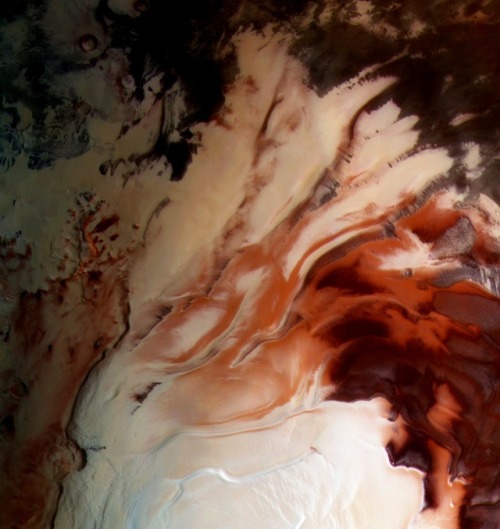
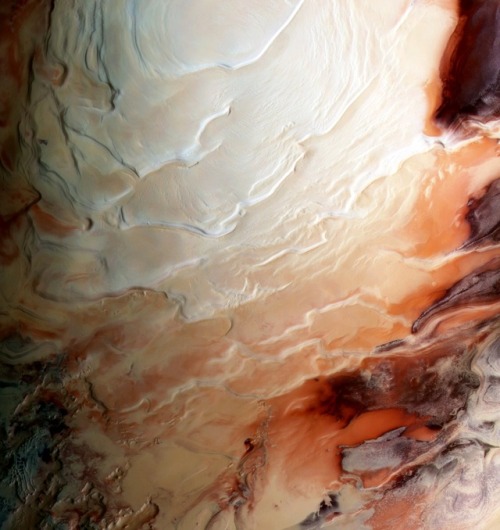
Martian North Pole
ESA / G. Neukum (Freie Universitaet, Berlin) / Bill Dunford
Cassini Mission: What’s Next?
It’s Friday, Sept. 15 and our Cassini mission has officially come to a spectacular end. The final signal from the spacecraft was received here on Earth at 7:55 a.m. EDT after a fateful plunge into Saturn’s atmosphere.

After losing contact with Earth, the spacecraft burned up like a meteor, becoming part of the planet itself.

Although bittersweet, Cassini’s triumphant end is the culmination of a nearly 20-year mission that overflowed with discoveries.
But, what happens now?
Mission Team and Data
Now that the spacecraft is gone, most of the team’s engineers are migrating to other planetary missions, where they will continue to contribute to the work we’re doing to explore our solar system and beyond.

Mission scientists will keep working for the coming years to ensure that we fully understand all of the data acquired during the mission’s Grand Finale. They will carefully calibrate and study all of this data so that it can be entered into the Planetary Data System. From there, it will be accessible to future scientists for years to come.

Even beyond that, the science data will continue to be worked on for decades, possibly more, depending on the research grants that are acquired.
Other team members, some who have spent most of their career working on the Cassini mission, will use this as an opportunity to retire.
Future Missions
In revealing that Enceladus has essentially all the ingredients needed for life, the mission energized a pivot to the exploration of “ocean worlds” that has been sweeping planetary science over the past couple of decades.

Jupiter’s moon Europa has been a prime target for future exploration, and many lessons during Cassini’s mission are being applied in planning our Europa Clipper mission, planned for launch in the 2020s.

The mission will orbit the giant planet, Jupiter, using gravitational assists from large moons to maneuver the spacecraft into repeated close encounters, much as Cassini has used the gravity of Titan to continually shape the spacecraft’s course.
In addition, many engineers and scientists from Cassini are serving on the new Europa Clipper mission and helping to shape its science investigations. For example, several members of the Cassini Ion and Neutral Mass Spectrometer team are developing an extremely sensitive, next-generation version of their instrument for flight on Europa Clipper. What Cassini has learned about flying through the plume of material spraying from Enceladus will be invaluable to Europa Clipper, should plume activity be confirmed on Europa.

In the decades following Cassini, scientists hope to return to the Saturn system to follow up on the mission’s many discoveries. Mission concepts under consideration include robotic explorers to drift on the methane seas of Titan and fly through the Enceladus plume to collect and analyze samples for signs of biology.

Atmospheric probes to all four of the outer planets have long been a priority for the science community, and the most recent recommendations from a group of planetary scientists shows interest in sending such a mission to Saturn. By directly sampling Saturn’s upper atmosphere during its last orbits and final plunge, Cassini is laying the groundwork for an potential Saturn atmospheric probe.

A variety of potential mission concepts are discussed in a recently completed study — including orbiters, flybys and probes that would dive into Uranus’ atmosphere to study its composition. Future missions to the ice giants might explore those worlds using an approach similar to Cassini’s mission.
Learn more about the Cassini mission and its Grand Finale HERE.
Follow the mission on Facebook and Twitter for the latest updates.
Make sure to follow us on Tumblr for your regular dose of space: http://nasa.tumblr.com.
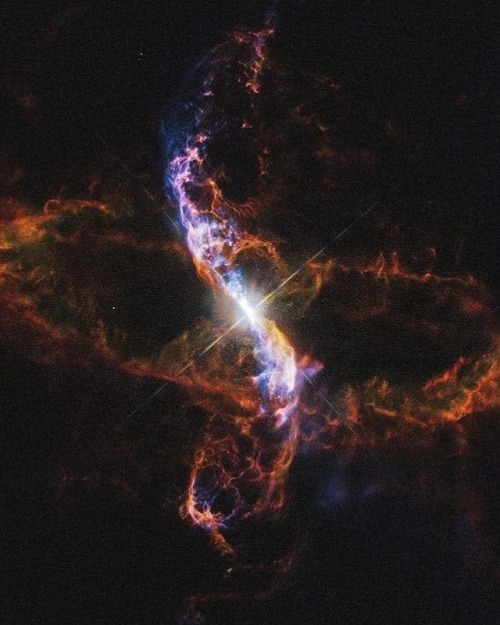
R Aquarii is known as a symbiotic star made up of a white dwarf–red giant binary pairing. These two stars are tied in orbit around one another with a period of around 44 years. The primary star is a variable red giant, meaning it changes temperature and undergoes drastic brightness fluctuations. The secondary star is a white dwarf that sucks in material from the red giant. Some of the extra material is sometimes ejected, forming the incredibly stunning nebula surrounding it.
(Credit: Hubble Space Telescope/Judy Schmidt)


Solar ❤
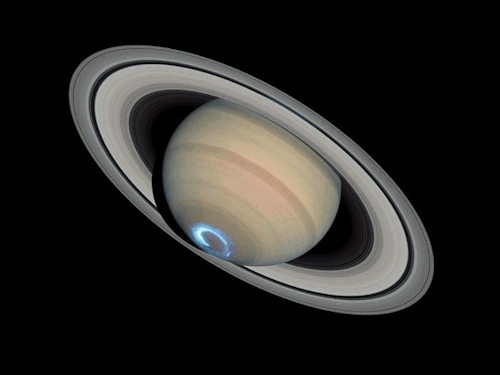
Sequence of images of auroras seen at the south pole of Saturn. Images combine visible and ultraviolet light.
Credit: NASA, ESA, J. Clarke (Boston University, USA), and Z. Levay (STScI)

False color image of Uranus taken with the Hale Telescope and the Palomar Observatory. The rings are the red pieces.
Image credit: Palomar Observatory & Hale telescope
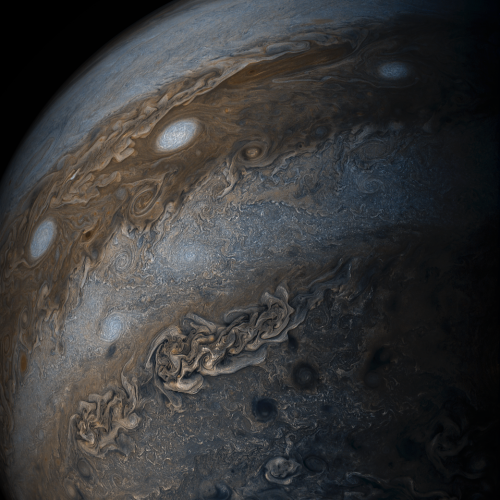
Jupiter’s Bands of Clouds
This enhanced-color image of Jupiter’s bands of light and dark clouds was created by citizen scientists Gerald Eichstädt and Seán Doran using data from the JunoCam imager on NASA’s Juno spacecraft.
Three of the white oval storms known as the “String of Pearls” are visible near the top of the image. Each of the alternating light and dark atmospheric bands in this image is wider than Earth, and each rages around Jupiter at hundreds of miles (kilometers) per hour. The lighter areas are regions where gas is rising, and the darker bands are regions where gas is sinking.
Credits: NASA/JPL-Caltech/SwRI/MSSS/Gerald Eichstädt /Seán Doran

Should there be a holiday called Astronomy Day?
Where lights are to be turned off for the entire night so everyone could see the stars?
-
 ooooxsblog liked this · 1 month ago
ooooxsblog liked this · 1 month ago -
 soniciselectricc liked this · 3 months ago
soniciselectricc liked this · 3 months ago -
 legendarykidherringsludge liked this · 3 months ago
legendarykidherringsludge liked this · 3 months ago -
 amandajasmine reblogged this · 3 months ago
amandajasmine reblogged this · 3 months ago -
 blackcatcore reblogged this · 3 months ago
blackcatcore reblogged this · 3 months ago -
 vvitcherys reblogged this · 3 months ago
vvitcherys reblogged this · 3 months ago -
 unregistered-hypercam002 liked this · 3 months ago
unregistered-hypercam002 liked this · 3 months ago -
 luvbites liked this · 3 months ago
luvbites liked this · 3 months ago -
 fullheartss liked this · 3 months ago
fullheartss liked this · 3 months ago -
 subtotem reblogged this · 3 months ago
subtotem reblogged this · 3 months ago -
 prince-of-lesbos liked this · 3 months ago
prince-of-lesbos liked this · 3 months ago -
 oflline reblogged this · 3 months ago
oflline reblogged this · 3 months ago -
 oflline liked this · 3 months ago
oflline liked this · 3 months ago -
 highonlife22 reblogged this · 3 months ago
highonlife22 reblogged this · 3 months ago -
 ohfallingstar reblogged this · 3 months ago
ohfallingstar reblogged this · 3 months ago -
 finnstansonly reblogged this · 5 months ago
finnstansonly reblogged this · 5 months ago -
 digitaloves reblogged this · 5 months ago
digitaloves reblogged this · 5 months ago -
 shyspice liked this · 9 months ago
shyspice liked this · 9 months ago -
 kawaiidesu reblogged this · 1 year ago
kawaiidesu reblogged this · 1 year ago -
 kawaiidesu liked this · 1 year ago
kawaiidesu liked this · 1 year ago -
 craftyrebelwitch liked this · 1 year ago
craftyrebelwitch liked this · 1 year ago -
 scorpiosource-moved reblogged this · 1 year ago
scorpiosource-moved reblogged this · 1 year ago -
 hxvnted-rxse reblogged this · 1 year ago
hxvnted-rxse reblogged this · 1 year ago -
 nessieac liked this · 1 year ago
nessieac liked this · 1 year ago -
 iwillruletheuniverse reblogged this · 1 year ago
iwillruletheuniverse reblogged this · 1 year ago -
 ohfallingstar reblogged this · 1 year ago
ohfallingstar reblogged this · 1 year ago -
 catastrophic-kiss reblogged this · 1 year ago
catastrophic-kiss reblogged this · 1 year ago -
 kostassus liked this · 1 year ago
kostassus liked this · 1 year ago -
 lostenvelope reblogged this · 1 year ago
lostenvelope reblogged this · 1 year ago -
 dollhandinfection reblogged this · 1 year ago
dollhandinfection reblogged this · 1 year ago -
 rocksopera reblogged this · 1 year ago
rocksopera reblogged this · 1 year ago -
 zombiequeer liked this · 1 year ago
zombiequeer liked this · 1 year ago -
 westernstarofthenorth reblogged this · 1 year ago
westernstarofthenorth reblogged this · 1 year ago -
 westernstarofthenorth liked this · 1 year ago
westernstarofthenorth liked this · 1 year ago -
 squirrel666 reblogged this · 1 year ago
squirrel666 reblogged this · 1 year ago -
 screamingwombatgirl reblogged this · 1 year ago
screamingwombatgirl reblogged this · 1 year ago -
 screamingwombatgirl liked this · 1 year ago
screamingwombatgirl liked this · 1 year ago -
 no-th0ts-just-vibes reblogged this · 1 year ago
no-th0ts-just-vibes reblogged this · 1 year ago -
 no-th0ts-just-vibes liked this · 1 year ago
no-th0ts-just-vibes liked this · 1 year ago -
 anynameisbetterthanmyfirstone liked this · 1 year ago
anynameisbetterthanmyfirstone liked this · 1 year ago -
 just-a-pointless-being reblogged this · 1 year ago
just-a-pointless-being reblogged this · 1 year ago -
 livmanchuk reblogged this · 1 year ago
livmanchuk reblogged this · 1 year ago -
 blueeunderthesamesky reblogged this · 1 year ago
blueeunderthesamesky reblogged this · 1 year ago -
 sticktoyourcatss reblogged this · 1 year ago
sticktoyourcatss reblogged this · 1 year ago -
 godmirror reblogged this · 1 year ago
godmirror reblogged this · 1 year ago
For more content, Click Here and experience this XYHor in its entirety!Space...the Final Frontier. Let's boldly go where few have gone before with XYHor: Space: Astronomy & Spacefaring: the collection of the latest finds and science behind exploring our solar system, how we'll get there and what we need to be prepared for!
128 posts